#broadsword
Text
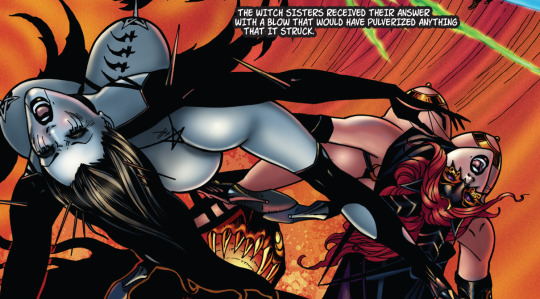
Tarot: Witch of the Black Rose #117 (2019)
2K notes
·
View notes
Text
no matter what your favorite sword is though you can find it in our zine!
#poll#swords#broadsword#katana#scimitar#cutlass#zweihander#broads and broadswords#broads and broadswords zine#lgbt zines#art zine#zines#armor#zine#art zines#nobinary zine#lgbtq#fantasy art#queer zines#broadswords#digital art#queer zine#women with swords#paladins#fantasy zine#wlw zine#lgbt zine#sapphic#wlw zines#illustration
1K notes
·
View notes
Text
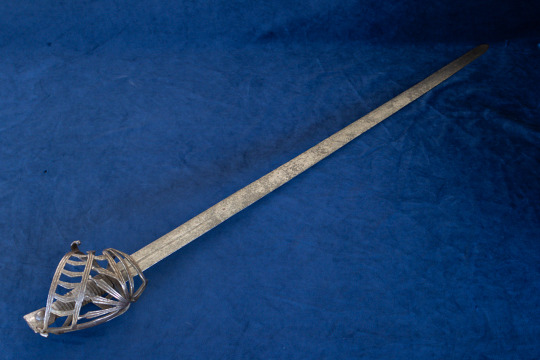
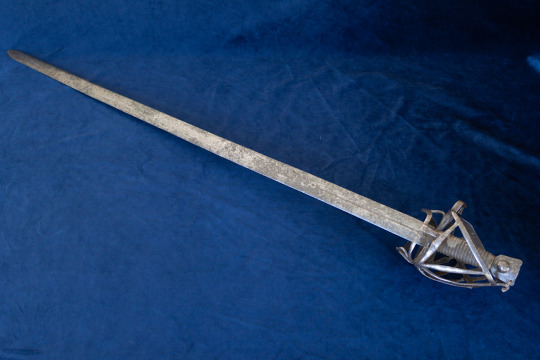
Early 18th Century Venetian 'Schiavona' Sword
The Schiavona is an iconic basket-hilted sword that was closely associated with the Italian city state of Venice. The earliest examples are believed to have come from an elite body of Slavic soldiers hired by the Venetian council, and date back as far as the late 16th Century.

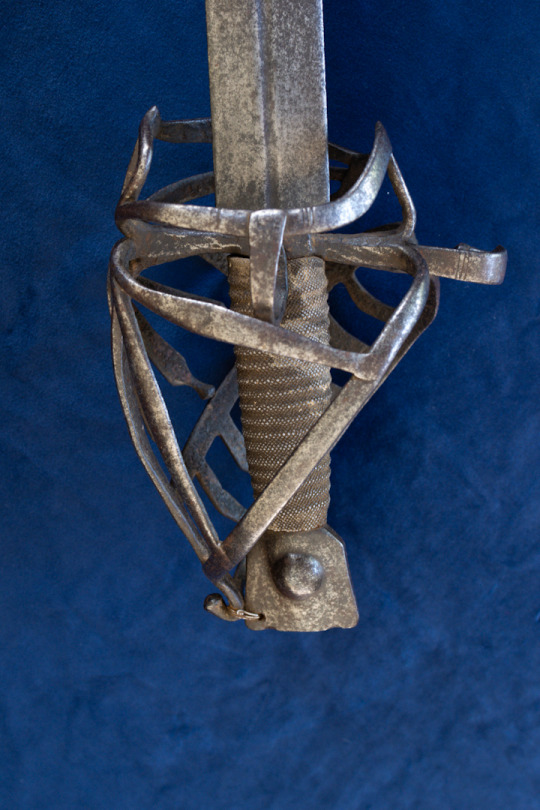
Schiavona are identified by their unique basket hilts and 'cats head' pommels. The renowned sword historian and author, Ewart Oakeshott grouped the schiavona basket hilts into two broad categories, the simplified Type 1 with it's broad flat bars, and the Type 2 of lattice work design.
They Type 1 hilt began to appear around the early 1600's and the first Type 2 between 1620 and 1630. Type 1's remained in use for most of the 17th Century after which Type 2 hilts became dominant.
Over the life of schiavona swords, (1600 - 1797) their hilts became increasingly complex and ornate as they became associated with the character of Venice, with the upper levels of society also carrying their own schiavonas.



Based on the features of the hilt, this sword most likely dates to 1710 - 1740. The iron pommel and 93 cm blade suggest that it is of munitions grade and was likely carried by a regular cavalry man.
Stats:
Overall Length - 1,075 mm
Blade Length - 930 mm
Point of Balance - 165 mm
Grip Length - 135 mm
Inside Grip Length - 94 mm
Weight - 1,090 grams
#swords#antique swords#military antiques#Italian#City of Venice#Cavalry swords#Schiavona#18th Century#Broadsword#basket hilt#Italian Basket Hilt
237 notes
·
View notes
Text
They call it a broadsword ’cause it’s for women
101 notes
·
View notes
Text
So, You Want to Write a Sword Fight.
Welcome to Your Local Sword Girlboy’s crash course on how to write a sword fight! We’re going to cover all the basics, from understanding context, to pacing, even some good ways to research! So buckle up gays, and let’s learn How to Sword.
First, what kind of sword are you wielding? There are so many different swords and forms and they’re all very different. But not only in the way you might think. Obviously the way the swords are held and wielded and the weight they have makes a difference how you write the battles, but even more so than that is TYPE OF FIGHT. Sabers, Epées, and Foils all have specific ways their bouts are set up and executed, and it has to do with a highly important cultural system of honor. Is this an honorable bout? Or a fight for survival? Or a fight for revenge? How much do these characters respect each other and how desperate are they?
This will affect the setup of the fight more than you think. For example, the target area. Or other weapons involved. If it is an honorable fight between two parties that respect each other, they will only hit on the front area of each others’ target, and will only make contact with their blades on each other. If it is a fight for survival, however, all bets are off. Any area on each others’ bodies is valid target area, and they might be more inventive while fighting, like slamming each other with the hilt, or using another improvised weapon nearby to win. It’s important to consider.
Now let’s talk about types of swords specifically. Sabers, Epées, and Foils are all incredibly light and whippy, and are held with one hand. They can be maneuvered very fast and can perform some very fast actions, and are GREAT for feinting (more on this later). They can change direction quickly with a whip of the fingers, and are usually used in very honorable bouts. Foils and Epées are for stabbing, while Sabers are for slashing opponents. All of these swords, though, use VERY small and quick movements. The fighter wielding one of these even makes themself smaller with a squatting stance and only one side facing the opponent. Everything is quick and precise. Footwork is key.
Rapiers and cutlasses are heavier, but still operated with one hand. These are favored by pirate types, and are used for slashing and sometimes stabbing. Another detail is that these can also be accompanied by a parrying dagger, held in the opposite hand as the Rapier and used for blocking the opponent’s blade out of the way.
Now the one you’ve been waiting for, longswords and broadswords (and lightsabers as well). These are usually two handed weapons, but can be one-or-two handed. They are heavier, and take more strength to control, but believe me when I say they are NOT clunky or slow. You CAN perform a feint with a longsword. I HAVE done it before (not successfully, but that’s just a skill issue on my part, let’s not dwell on it). The way these swords are maneuvered are with wider swings, for cutting OR slashing, and to protect the whole body. Footwork is important as well, but it’s terrible on the knees if you run too much with these (because they’re so goddamn heavy) so it’s not like you can run a marathon with a longsword like you can with a foil or saber. (of course if it’s a lightsaber all bets are off bc that thing is made of light and it's wielded by a space wizard so whatever).
Alright next. Let’s get GRANULAR. Let’s talk about very specific types of attacks and blocks and how to phrase this. Now, don’t worry, you don’t have to be a fencing expert to talk about the specific moves, because the audience will understand what you’re saying. It’s just about being specific enough to where you can paint a picture in their heads but not too specific to where the fight loses its suspense.
So, first, let’s talk about attacks and blocks, and what to call them. For any sword, extending the blade is holding it out in front of you. Thrusting is when you make a jabbing attack with the blade. And finally, lunging is when you throw your body forward with the attack, specifically throwing out your front leg and leaning into it, while keeping your body level with the floor to keep balance and make it easy to recover into a guard position.
Now for blocks. Pushing the blade out to block the opponent’s blade is called a parry. When you attack your opponent back immediately after taking their blade in a parry, it’s called a riposte. You don’t need to use this word, though, because I’ve found that just saying something like “They parried her blade and then thrusted towards her chest,” works quite well.
SIDE NOTE: if both of your opponents have the same pronoun set, I’m so fucking sorry. It doesn’t get any easier. It’s the Gay Fanfiction Dilemma, I’m afraid. But if you’re already versed in that, use the same workarounds for pronouns and titles for fighting as you do for fucking, it works pretty much the same way ;). (But PLEASE don’t be afraid to use their names. I promise nobody is going to kill you if you say the characters' names twice in a single paragraph. It’s MUCH better than having to read “the blond” or “the tall one” or “the younger woman.”) Basically, just use their names a lot. It’s quicker and I promise you it works.
Now where were we? Ah yes. Attacks and blocks. I already covered those, but surprise, there’s a secret third thing, and it’s my very favorite move. Feinting. It’s quite simple really, it’s an extension of the blade, a faked attack, to get your opponent to try to parry or block or move their blade, only to switch your movement to avoid their blade and attack them back. It’s fun and can be extremely effective, and it also can be used in many different types of ways. Any way you can get your opponent to try to parry your blade in one place, like a high or a low attack, expect where their blade is going to be, and then avoiding it works as a feint. Or you could engage the blade, and move it around with your own blade to get it away from your target area and slide in for a riposte. This is my specialty. And it makes a KILLER shiiiiiiing sound as well. It sounds confusing, but it can actually be written quite simply. Let’s give an example:
“A thrusted out their blade in a feint. But just as B’s blade leaped for it, A withdrew their arm and took B’s blade up in a quick engagement. They swung it around and metal scraped against metal as A pushed B’s blade away from pointing at their chest to a harmless position beside their thigh. Then, in the same flowing movement, blades still locked, A pushed their blade back up for a deadly thrust at B’s chest.”
Not bad, if I do say so myself. Although this comes from having executed that maneuver a hundred times personally. There’s still hope for you though, as a non-fencing sword writer, I promise! You just gotta research and read a bit. But more on that later.
Next let’s talk about footwork. It’s not the most important part of the fight, but it is worth mentioning every once in a while in your scene, just to give the audience a sense of space for where your characters are, especially if they’re in a precarious position like a mountain or a pirate ship. Remember that swordfighting requires a LOT of backwards and forwards movement on both parties’ parts, so give your characters lots of room!
That brings us to our next point. Pacing. Now, here’s something you NEED to know about real life sword fights. They are MUCH faster than you think they are. Most of the fight is pacing back and forth, trying to gain right of way (if you’re in foil), and testing your opponent to see where they’ll go. Just a few seconds of blade engagement, and then it’s back to pacing back and forth to see who’s going to jump first. Also some testing to see how trigger happy your opponent is but thrusting towards them and seeing if they’ll attack back or retreat. Basically, irl sword fights are just 70% foreplay and 20% actual stabby stab.
But this is not great for fun sword fight scenes! Remember it’s okay to stretch the truth, and focus on the swordplay actions, stretch them out as much as necessary. Especially if your characters are superhuman. Just consider throwing in a few moments of pacing and sussing each other out, I promise it’s worth it. Not just to break up the constant fighting, which can get tiresome, but also because characters get tired too! Superhuman or not, fighting is exhausting on all parties. It’s not unusual for two sword fighting individuals to suddenly break and have a moment of analysis, slowly circling each other. I promise it won’t break your tension, if anything it will just increase it.
Now let’s talk about how to ACTUALLY get better and writing these scenes. And no, I’m not going to say ‘practice.’ Because while practice is important, so is RESEARCH and OBSERVATION.
There’s many ways you can research and observe as a non-sword individual! First I recommend watching clips of actual sword fighting, specifically women’s olympic foil (because they have the most technique out of all the other swords and categories). Also, watching sword fighting scenes in movies is good. It’s a dramatized version, of course, but that’s exactly what we’re trying to achieve in writing. It’s good to watch the character’s perspectives as they fight, and how the action washes over us as an audience.
Finally, I recommend actually reading sword fights in stories. The best author for fantasy sword fights, hands down, is R.A. Salvatore. His books are super cool D&D fantasy quest stories centered around a badass but also cute and compelling Drow character who gets into sword fights ALL THE TIME. And nobody writes a sword fight like Salvatore. Reading his work has probably helped me more in writing sword fights than my actual knowledge of how to sword fight.
I hope this has helped somewhat! Or was just fun to read. Either way, I enjoyed writing it. I love writing sword fights and I love sword fighting and I love helping, so I was happy to make this. Also, I have lots more technical knowledge I would love to share on this subject, so if you have anything you want to know about how swords or sword fights work or how to write something, I’m open for asks! Even if I don’t know you! Feel free to reach out with a question or a comment, I’ll geek out about swords any day.
Anyway that’s it my writer friends and fellow sword enthusiasts, good luck and happy writing! <3
@veradragonjedi
#sword fights#writing tips#writers on tumblr#how to write a sword fight#fencing#foil#epee#saber#longsword#broadsword#airlocks writes#writing tutorial#long post
274 notes
·
View notes
Text
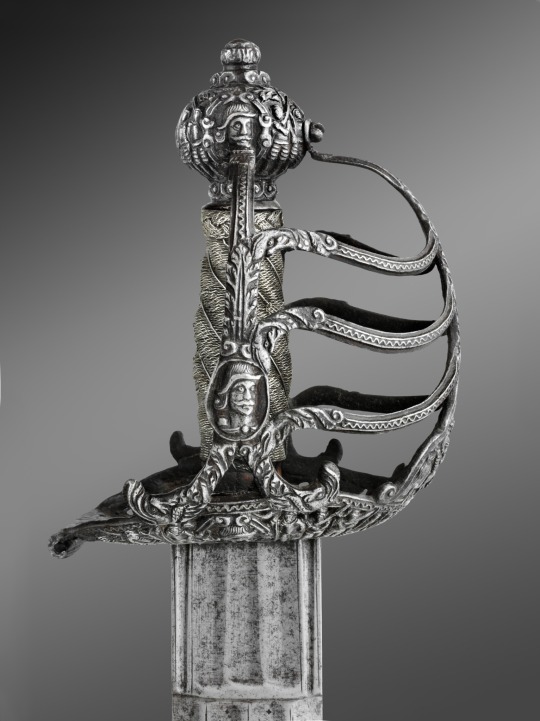



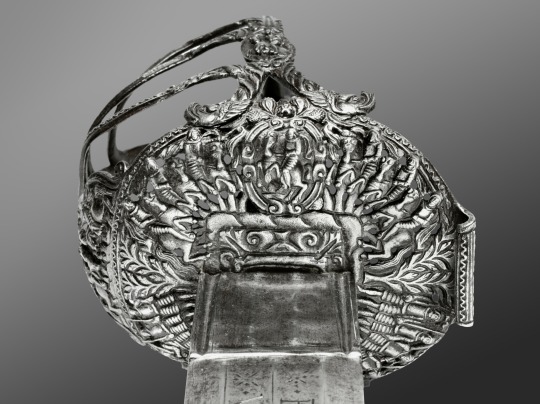
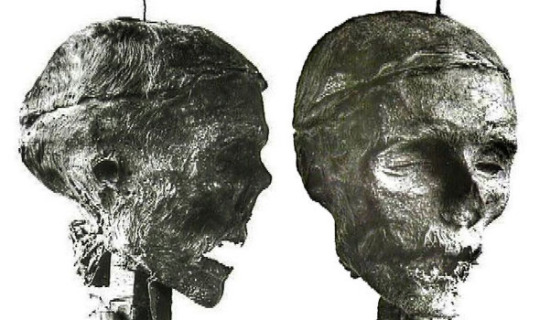



⚜️ Broadsword of Oliver Cromwell, England, c. 1650
Medium: Iron alloy (steel), partially engraved; chiseled; silver wire; wood
Length (overall): 96.8 cm
Blade: 82.6×4.9 cm
Hilt: 12.9×11.7 cm
Pommel: Height-5.4 cm, Diameter-3.3 cm
Weight: 1405 g
Facts:
▪️ August 9, 1655 - Lord Protector Oliver Cromwell divides England into 11 districts
▪️ Cromwell is an iconic figure in British history
▪️ He was a key figure in the trial and execution of King Charles I
▪️ He has the peculiar distinction of being the only political criminal to be executed two years after his death
Cromwell was exhumed from his grave in 1661 and put on trial by the late king's son, Charles II. Posthumously convicted of high treason, Cromwell's corpse was hanged and beheaded, and his head was impaled on a 6-meter spike atop Westminster Hall. The mummified head remained on the spike for more than 20 years
▪️ In 1960 (300 years after Cromwell's death), Dr. Horace Wilkinson donated the head to Sidney Sussex College at Cambridge, Cromwell's alma mater
"Cromwell's head is buried somewhere in the college chapel, supposedly in a biscuit tin" (says Stuart Orme, curator of the Cromwell Museum)
▪️ Cromwell's most famous quote is "Put your trust in God, my boys, and keep your powder dry," but there's no proof that he actually said it. The line comes from a 19th-century poem called "Oliver's Advice" based on a "well-authenticated anecdote" associated with Cromwell
▪️ September 3 is a fateful date: Cromwell routed the Scots at Dunbar (1650). The Battle of Worcester would prove to be the final action of the English Civil Wars (1651). Cromwell's first Parliament met on 3rd September, 1654.
▪️ Cromwell died suddenly at age 59 on 3rd September 1658. He suffered from a lethal combination of malaria and typhoid fever.
- -
⚜️ Палаш Оливера Кромвеля, Англия, ок. 1650
Материалы: сталь, гравировка; серебряная проволока; дерево
Длина (общая): 96,8 см
Лезвие: 82,6×4,9 см
Рукоять: 12,9×11,7 см
Навершие: высота-5,4 см, диаметр-3,3 см.
Вес: 1405 г
Факты:
▪️ 9 августа 1655 г. Лорд-протектор Оливер Кромвель делит Англию на 11 округов
▪️ Оливер Кромвель - человек, повлиявший на ход истории Англии
▪️ Он был ключевой фигурой в судебном процессе и казни короля Карла I
▪️ Известен тем, что является единственным политическим преступником, казненным через 2 года после своей смерти. Был эксгумирован в 1661 г. и предан суду сыном покойного короля Карлом II. Посмертно осужденный за государственную измену, труп Кромвеля был повешен и обезглавлен, а его голова была пронзена 6-метровым штырем. Мумифицированная голова оставалась на крыше Вестминстерского дворца более 20 лет
▪️ В 1960 г. (через 300 лет после смерти Кромвеля) доктор Гораций Уилкинсон пожертвовал его голову колледжу Сидни Сассекс в Кембридже, альма-матер Кромвеля.
"Голова Кромвеля похоронена где-то в часовне колледжа, предположительно в банке из-под печенья" (Стюарт Орм, куратор музея Кромвеля)
▪️ Самая известная цитата Кромвеля: "Уповайте на Бога, мальчики мои, и держите порох сухим", но нет никаких доказательств того, что он действительно это сказал. Эта строка взята из стихотворения XIX в. под названием "Совет Оливера", основанного на "достоверном анекдоте", связанном с Кромвелем
▪️ 3 сентября - роковая дата Кромвеля. В этот день он одержал победу над шотландцами при Данбаре (1550), разгромил отряды Карла I в Вустере (1651). Первое заседание созданного Кромвелем парламента (1654), после чего этот день был объявлен Днем благодарения.
▪️ Умер 3 сентября 1658 г. в возрасте 59 лет от малярии и брюшного тифа
#кромвель #Cromwell #Broadsword #палаш #меч #вооружение #armsandarmor
#medieval#средневековье#middleages#history#история#arms and armor#broads and broadswords#broadsword#вооружение#меч#палаш#кромвель#оливер кромвель#oliver cromwell
93 notes
·
View notes
Text
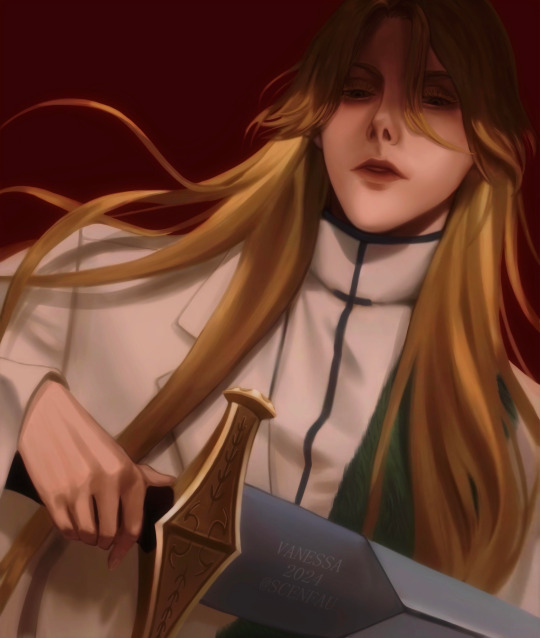
Jugram Haschwalth painting done entirely in Krita.
20 notes
·
View notes
Text
i learned there’s a limit to the amount of answers you can have in a poll 💀💀💀💀
if i forgot someone’s favorite tell me
#sword#swords#scimitar#rapier#smallsword#shortsword#longsword#broadsword#hook sword#saber#cutlass#katana
52 notes
·
View notes
Text
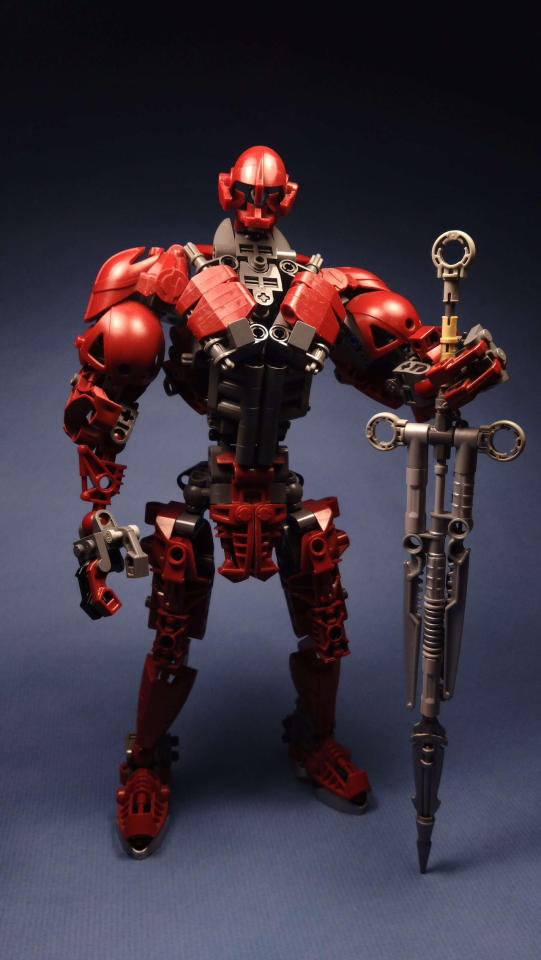

Neyiss, The Erathurian
"Speak softly and carry a big [metal] stick."
Source
Creator: Shorjok
#lego#bionicle#armor#armor plates#warrior#mysterious#mysterious warrior#humanoid#robot#robotic#robotic unit#sword#broadsword#humanoid robot#brawler#bruiser#bricks#giant#giant sword
65 notes
·
View notes
Photo

swords and stuff
188 notes
·
View notes
Text
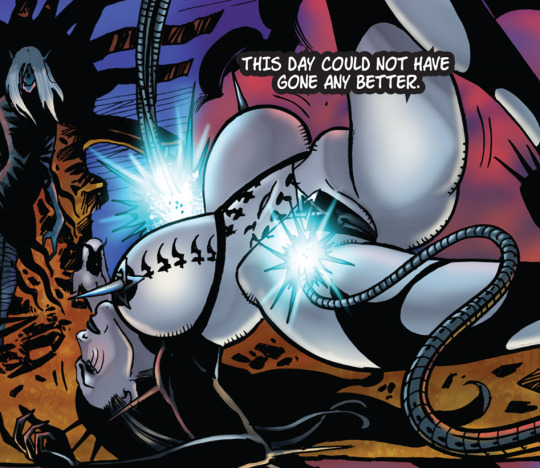
Tarot: Witch of the Black Rose #117 (2019)
195 notes
·
View notes
Text

Got the SWTOR survey! Really interested in seeing what the questions are, so hopefully the work day goes by fast.
32 notes
·
View notes
Photo
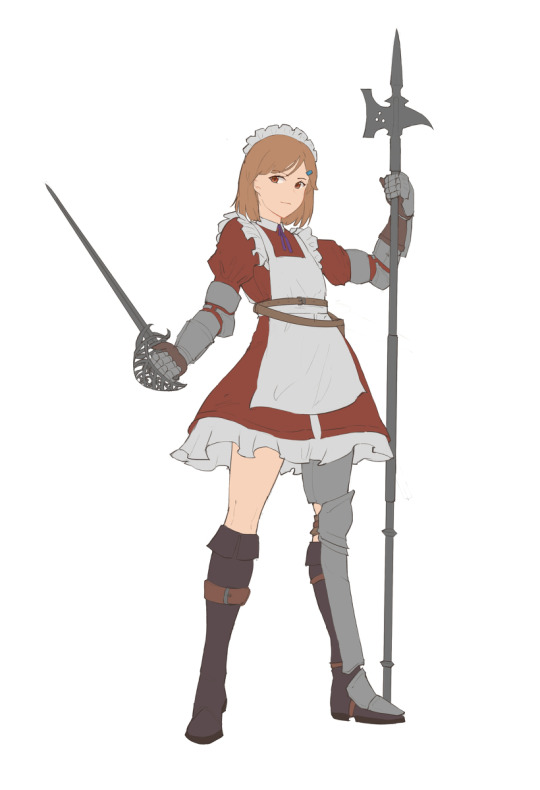
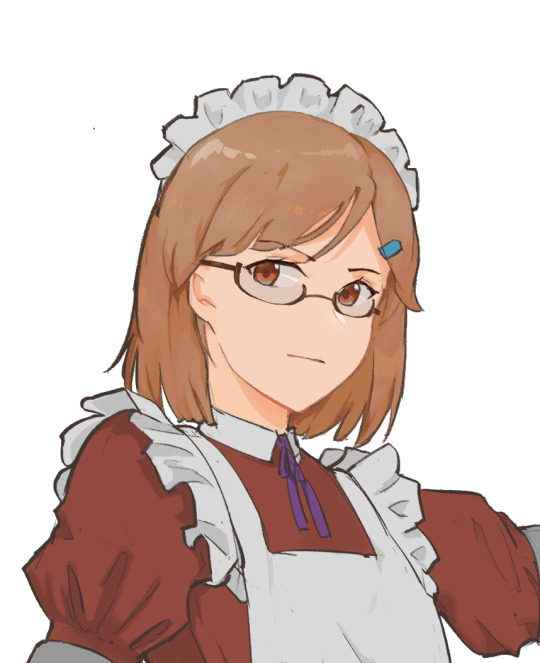
by Old Face
208 notes
·
View notes
Photo

A new sword for the collection that is a significant diversion from my core collecting theme.
Circa the mid-17th Century, this style of sword is unique to the British Isles and was popular from around the time of the English Civil wars (1642 - 1651) up until the 1670s.
The prominent features of the style are a three-bar basket connected to a round pommel by screws. Joining the bars, are usually one or two pairs of crossbars across the front. The top of the hilt is normally a bowl shape with a flat tail at the back. The blades can be either double edged broadswords (like this one) or single edged backswords. In period this likely how they would have been described in armouries or wills.
Also distinctive is the level of decoration that features on the guard, with faces being the most common but not exclusive theme. The meaning behind the faces is lost, but some theories are that it was the Martyred King Charles I. And while this may be true for specific swords, the faces appear on swords with provenance to both sides of the conflict so is unlikely to be true.

To modern collectors and books, these are called Mortuary swords, a name that came into being in the Victorian era. Again, it is not known why, it could be the likeness of the King or that many swords were sold out of Church collections where they had been used for funeral rites. In 1700s it was the practice to donate a soldier’s sword to his church, who would paint them black and put them on display at funerals.
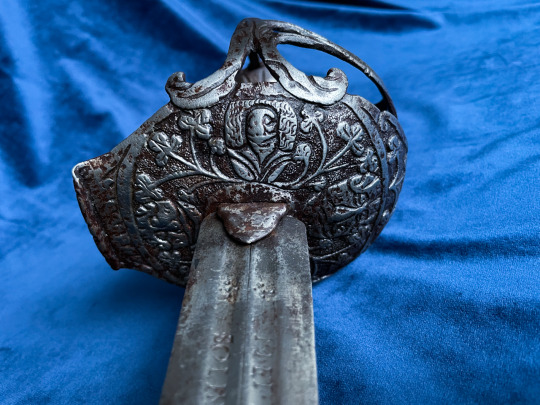
In the 19th Century, many churches were renovating and sold off these swords to interested collectors. Because of the practice of painting the metal, many remained in very good condition.
Typically associated with the cavalry, they were used by infantry as well, although a decorated sword such as this would have belonged to a man of some means. This sword is likely to be an infantry mans’ sword due to its’ lighter weight and shorter length, even if we account for it having lost the point of the blade. Another common modification to swords of this age was the replacement of the grip and wire. Wood does not age as well as steel and it is safe to assume that most 17th Century swords have had the grip re-done. Early collectors and museums looked on artifacts as works of art more than pieces of history, so like a painting restoration, they sought to re-make swords in their image of what they thought it should be.
I believe that this sword possibly came from one such church, as the blade is still stained and there are traces of black finish on the guard. Most of the blades for these swords came from three sources, the English Hanslow smiths, The Low Countries and of course Solingen. However, one cannot go by the markings alone, as forgery was wide spread.
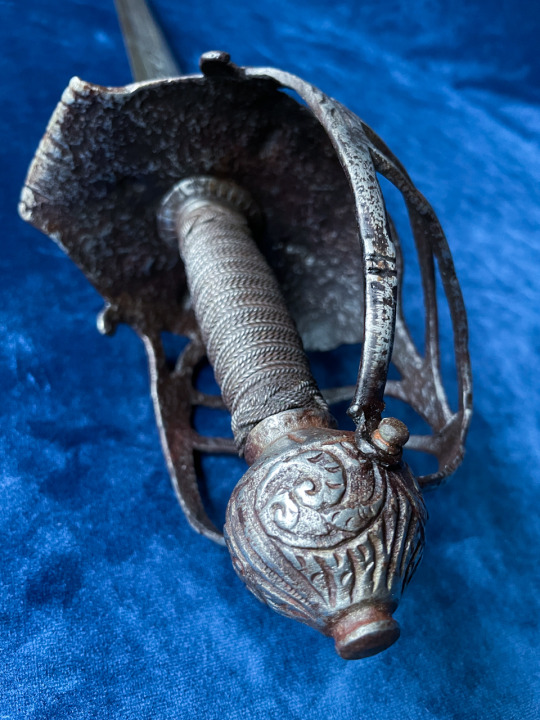
The blade on this sword has several interesting features. It is marked on both sides with the words:
MEFECIT A running Wolf and Tree stamp SAHAGVM
SOLINGEN SAHAGVM
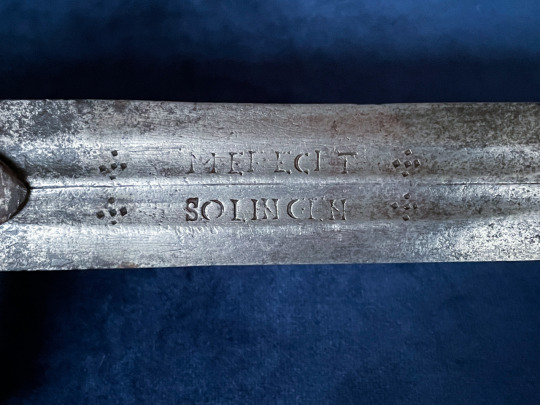


Sahagvm is a reference to Alsonso de Sahagun, el viejo a legendary Spanish
sword smith of the 16th Century. The name features prominently on Dutch ‘Walloon’ swords of the time and is an obvious forgery in line with the ‘Andrea Ferara’ swords of the Scottish Highlanders. Furthermore, the orientation of the wolf in relation to the text is incorrect likely ruling out manufacture in Solingen proper. However, this was a time of trouble, and many families of smiths left their German base to settle in the Low Countries, Britain or further abroad.
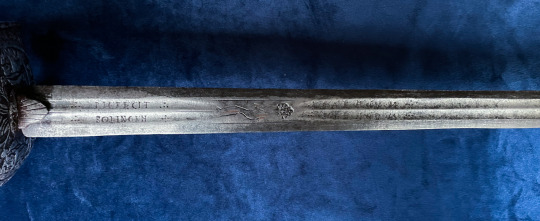
A light sword, the blade specifications are still functional and a close match to those of my 1796 Pattern Heavy Cavalry dismounted service sword with the Andrea Ferara blade.
Overall Length: 992 mm
Blade Length: 830 mm
Grip Length: 146 mm
Inside Grip Length: 100 mm
Weight: 860 grams
Point of Balance: 85 mm
#swords#17th Century#English Civil War#Cavalry#Infantry#Broadsword#Basket-hilt#antiques#military#collection#collecting history
337 notes
·
View notes
Text

Me in Star Wars: The Old Republic compared to me in Final Fantasy 14. These games have very different vibes.
#SWTOR#star wars#the old republic#FFXIV#final fantasy 14#mandalorian#bounty hunter#miquo'te#mmo#lucasfilm#square enix#ea#disney#broadsword
13 notes
·
View notes
Photo

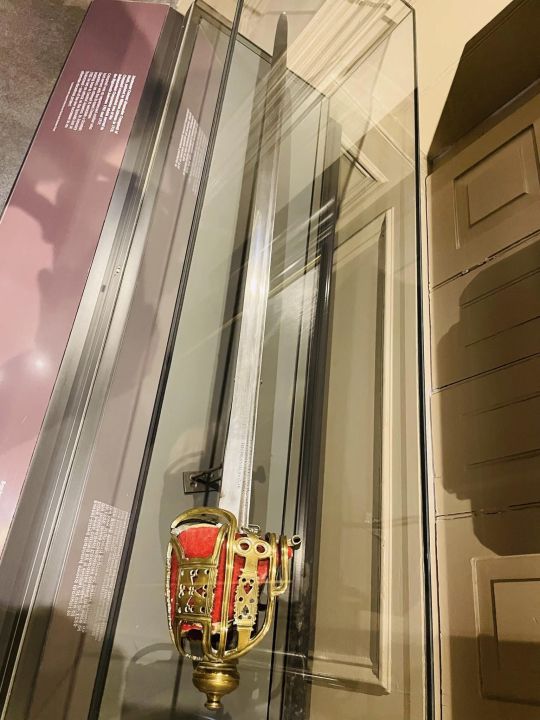
Broadsword believed to have belonged to a Black Watch officer, likely seeing service during the War of the Austrian Success/1745 Jacobite Rising and the Seven Years War.
Also for some weird reason even though the pics are the right way up Tumblr turns them like this, so yeah.
#sword#broadsword#black watch#history#military history#18th century#british army#scotland#scottish#highlander#jacobite
156 notes
·
View notes